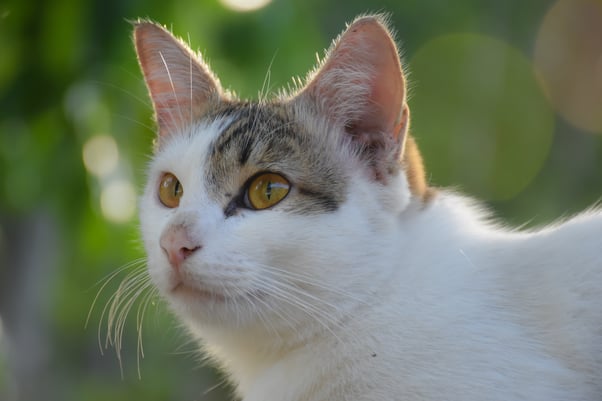Cat Ear Language: What is Your Kitty Telling You?
Cats are capable of a huge range of communication that, let’s be honest, puts us humans to shame! From facial expressions and vocalizations to the subtlest shifts of their tail, their options for sending a message are seemingly endless. But what about their ears?
Well, amazingly, a cat’s ears can signal a whole array of emotions too! Perhaps this is unsurprising, considering they have 32 muscles in each ear compared to just 3 for us humans.
So, what can we as pet parents do with this fascinating knowledge? As it happens, understanding cat ear language can help us better respond to our felines’ needs. In this article, we’re decoding the hidden meanings behind cat ear positions and what they say about how our kitties are feeling
Understanding the Anatomy of a Cat’s Ear
First up, let’s take a look at the science behind (or inside?) a cat’s ear. Here’s a quick breakdown:
- Highly Mobile—Cats have 32 muscles that control the pinna of each ear, allowing for incredibly precise movements and a wide range of motion. The pinna is the outer part of a cat’s ear that is visible, and that funnels sound waves into the ear canal.
- Independent Movement—Cats can move each ear separately, rotating them around 180 degrees. This enables them to detect sounds from multiple directions, accurately pinpointing potential predators and prey alike—a bit like radar.
- Henry’s Pocket—The little pocket at the side of a cat’s ear, near the base, has the cute name of Henry’s Pocket, and is thought to aid in sound detection. It also has the scientific name of cutaneous marginal pouch, though that’s much less fun!
- Ear Furnishings—The hairs inside some cats’ ears also have a name: ear furnishings. These may be there to help with picking up sounds that are quiet or a long way away. Interestingly, some cat breeds also have tufts on the tips of their ears, though these don’t contribute to their hearing.

Decoding Cat Ear Positions
A cat’s ear position meaning can reveal a lot about how they feel in the moment. Let’s explore some common cat ear signals and their meanings.
Relaxed Ears: A Sign of Contentment
When a cat’s ears are in their natural position—facing forward but relaxed—it usually means they’re comfortable and at ease. This neutral stance suggests your cat feels safe and might even accompany slow blinks or gentle purring. This is a positive cat ear position meaning that indicates trust in their environment.
Forward Ears: Curious & Alert
Cat ears that are tilted forward and upright signal interest in their surroundings. This is often seen in situations such as when your cat is exploring a new environment, watching birds outside, or is even engaged in play.
Perked to One Side: Assessing the Environment
If your cat’s ears are slightly tilted to one side, they might be processing an unfamiliar sound or gauging a situation. This cat ear language suggests your cat is on alert but not necessarily afraid—they’re just gathering more information before deciding if a noise represents a threat.
Ears Facing Backwards: Caution or Mild Irritation
When a cat’s ears are beginning to angle backwards, they may be feeling uncertain or mildly irritated. If you’re petting your cat and notice this change in their body language, it’s a sign they may not be enjoying the interaction as much as you think! Best put it to a stop.
Flat Ears: Fear or Stress
If a cat’s ears are flattened against their head—and in some instances when they’re rotated to the side or backwards—they’re likely feeling frightened or threatened. The degree of flattening can indicate how severe their discomfort is. For example, when a cat is extremely scared, their ears may seem almost invisible.
This cat ear signal is often accompanied by other signs such as dilated pupils, a lowered tail, or a tense body. If your cat frequently displays this posture, consider using a FELIWAY Optimum diffuser to help them feel more secure in the home. You should also spend a little time working out what’s causing this fear as it may be something we can easily address.
Twitching Ears: Irritation or Sleep Movements
If your cat’s ears are twitching, there may be something particularly annoying in the environment, such as a buzzing fly. Alternatively, twitching ears can also be seen when a cat is dreaming in deep REM sleep!
However, if your cat is flicking their ears excessively or scratching at them, it may indicate an ear infection or skin irritation. A visit to the vet is recommended in this situation in case there’s something going on with the health of their ears or the skin around them.
Why Understanding Cat Ears is Important
Observing your cat’s ear signals in combination with their body language, tail position, and vocalizations can provide a complete picture of how your cat is feeling. Whether they’re calm, curious, or anxious, paying attention to the meaning of cat ear positions is great for helping us understand and respond to their needs!
Remember, if your cat is displaying signs of stress or discomfort, FELIWAY Optimum can be a big help. This clever diffuser uses a new pheromone complex to promote a sense of calm and security for your cat, especially during any stressful situations.
To learn more about cats and their fascinating behaviour, why not check out all our other articles online? You can also receive our latest guides and tips straight into your inbox by signing up for our newsletter!

